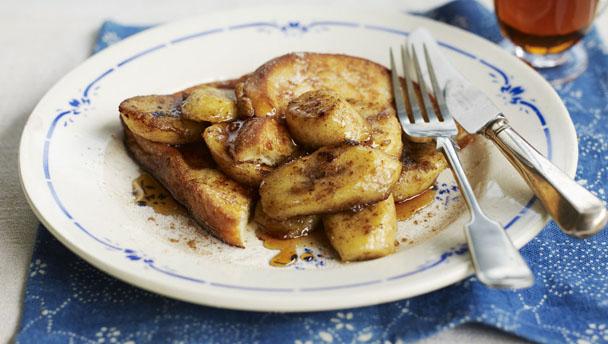

By Allegra McEvedy
Bananas are widely grown across the tropics and sub-tropics. They grow in hands (bunches) of five to 20 fingers (bananas). Depending on the variety, they can be small or long, thin- or thick- skinned, with yellow or red skins. They are picked when two-thirds ripe and slowly convert their starch to sugars as they’re shipped.
 Honey-glazed guinea fowl with pomegranate and pineapple
Honey-glazed guinea fowl with pomegranate and pineapple
 Fruity fritters
Fruity fritters
 Banana pancakes with streaky bacon
Banana pancakes with streaky bacon
 Crunchy banana yoghurt
Crunchy banana yoghurt
 Sweet banana and maple pancakes with blueberries and pecans
Sweet banana and maple pancakes with blueberries and pecans
 French toast with bananas and maple syrup
French toast with bananas and maple syrup
 Thai fish cakes with a honey and cucumber dip
Thai fish cakes with a honey and cucumber dip
 Fresh fruit salad
Fresh fruit salad
 Best-ever banoffee pie
Best-ever banoffee pie
 Fruity kebabs
Fruity kebabs
 Banana and chocolate chip loaf
Banana and chocolate chip loaf
 Chocolate banana cake
Chocolate banana cake
 Banana bread
Banana bread
 Banana cake
Banana cake
 Summer fruit smoothie
Summer fruit smoothie
 Cardamom and beetroot smoothie sundae
Cardamom and beetroot smoothie sundae
 Chocolate avocado shake
Chocolate avocado shake
Bananas are often sold still green but will ripen to yellow.
Avoid storing bananas near ripe fruit as they release a lot of ethylene, which will cause the other fruit to ripen further.
Lemon or lime juice, natural yoghurt or soured cream all bring out the natural sweetness of ripe bananas, especially in fools, drinks, mousses and ice creams. Lemon juice or acidulated water help prevent sliced bananas from browning in trifles and pancakes.
Bananas are excellent cooked as fritters, flambéed, or simmered in coconut milk. Rum, orange, cardamon, toffee, vanilla, and chocolate are popular pairings. Mashed bananas give a moist, chewy texture to cakes and muffins. Over-ripe, chocolate-skinned bananas can be used in banana bread or ice cream, but add extra lemon to the latter before using.
Article by Sybil Kapoor
Type the ingredients you want to use, then click Go. For better results you can use quotation marks around phrases (e.g. "chicken breast"). Alternatively you can search by chef, programme, cuisine, diet, or dish (e.g. Lasagne).